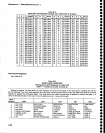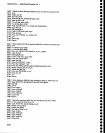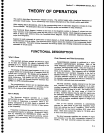
O
o
o
o
o
a
o
o
o
O
o
a
o
o
o
t
a
o
o
a
o
o
o
o
o
o
o
a
o
O
a
o
o
o
o
a
a
o
o
O
a
o
o
o
First,
Second,
and
Third
Converters
Swept-frequency
anatysis
is
achieved
by
a
triple-
conversion
superheterodyne
technique.
Each
of
'the
three
frequency
converters
consists
of a rnixer,
a local
oscillator,
and
appropriate
filters.
Only one
frequency
is
converted
in
each
mixer
to
pass
through
bind_piss
filters
to the
detector.
This
frequency
can
be changeO
by tuning
the
local
oscillator
trequency
in
the first
or
second
convErters.
The
third converter
uses
the
fixed
100
MHz
calibrator
signal
as
a stable
local
oscillator.
An external
source
may
also
be
used
as
a reference
for
the 100
MHz calibrator
and
third converter.
The
first
converter.
usually
referred
to as
the
front
end,.
converts
the input
signal
frequency
to an
inter-
mediate
frequency
(tF)
of
either
g2g
MHz or
ZO72
MHz,
depending
on
which
band is
in
use.
The internal
mixer
converts
signals
over
the input
range
of
10kHz
to
21
GHz.
External
mixers
may
be used
for
signals
into
the millimeter
wavelengths.
When
the internal
mixer
is
used,
a
preselector
or low-pass
filter
is inserted
in
the
signal path
to reduce
unwanted
signals
or
images
and
spurious
responses.
One of
two second
converters
is automatically
selected
for
each
band
so
the input fr6quency
range
does not
overlap
the first
lF
frequency.
Each second
converter
has
its
own
local
oscillator (LO),
mixer,
and
filters.
Both
down-convert
the signal
to 110 MHz
which
is sent
to
the
third
converter.
The
third
converter
amptifies
the
110
MHz
lF signal
and
converts
it
to
the final
intermediate
frequency
of
10
MHz.
The
third converter
passes
the signal
to the
Secton
7
-
494A1494Ap
Service,
Vot.
1
THEORY
OF
OPERATION
This
section
describes
the
spectrurn
analyzer
circuitry.
The
section
begins
with
a functional
description
of
the
maior
circuit
blocks'
This
is
fotloweJ
6y'ror"
detailed
descriptions
of
the circuitry
within
each
block.
while
reading
these
descriptions,
refer
to
the coresponding
block
or
schematic
diagram
in
volume
2 of
the
service
Manual'
The
description'tittes
use
ir,e
oi"grar
nam-es
and
numbers
for
easy
reference.
The
Functional
Block
diagram,
located
at
the
front
of
the
Diagrams
section
in
Volume
2.
shows
how
the
major
sections
in
the instrument
relate
andihe.paths_of
*o.1
r-"pr
signals.
Block
diagrams
showing
more
L::*;ffi?#:llr:*tions
rollow
ttre
Functiinat
Brock
oiagr;;.
Gircuit
schematicliasrams
ror6w
the
Adjacent
to
each
schematic
is
a
third
level
of
block
diagram,
a circuit
board
parts
location
illustration,
and
cross-reference
look-up
tables.
The
third
level
block
diairam'snows
the function
of
the Lornpon"nt"
shown
on
the
schematic'
The
parts
location
illustration
ano
tooi-uf
t"or".
aid
in
finding
components
on either
the
schematic
or
circuit
board.
FUNCTIONAL
DESCRI
PTION
What
lt
Does
The
spectrum
analyzer
accepts
an
electrical
signal
as
its
input
and
displays
the
signal,s
frequency
com_
nn:t:.9n
a
crt.
Signats
can
beapptied
direcily
to
the
RF
fNPUT
or
through
an
external
mixer.
The
display
of
the input
signat
appears
on
the
crt
as
a
graph
where
the
horizontal
axis
is'frequ€ncy
and
the
v.ertjcal
axis
is
arnptitude.
The
disptay
can
be
ptotted,
i,
desired,
by connecting
a chart
recorder
througn
rear_
panel
connectors.
The
display
can
also
be
transmitted
digitally
via
a
|EEE
4gg
Geneiar
purpose
Interface
Bus
(GPIB)
to a
GptB-compatible
ptotter.
The
programmable
version
can
be operated
either
T:H"lll.*jih
front-panet
controts,
or
remotety
via
rhe
\rFtE
wtrn
an
easy_to_use
programming
language.
How
lt
Works
The
Spectrum
Analyzer
operates
as
a
swept,
narrow-band
receiver.
The
crt
beam
moves
norizontatty
as
a
range
of
frequencies
is
spanned.
When
a
fre_
quency
component
of
an
input
signat
is
detected,
the
beam
is
deflected
vertically
as
a
fuiction
oi
inprt power
at
that frequency.
Frequency
is
measured
by
counting
the local
oscilla-
tor lrequencies
against
a reference.
Amplitude
is
meas-
ured
by catibrating
the
REFERENCE
LEVEL
and
RF
attenuator.
A
master
microcomputer
performs
control,
storage,
signal processing,
and
communications
func_
tions.
7-1


















